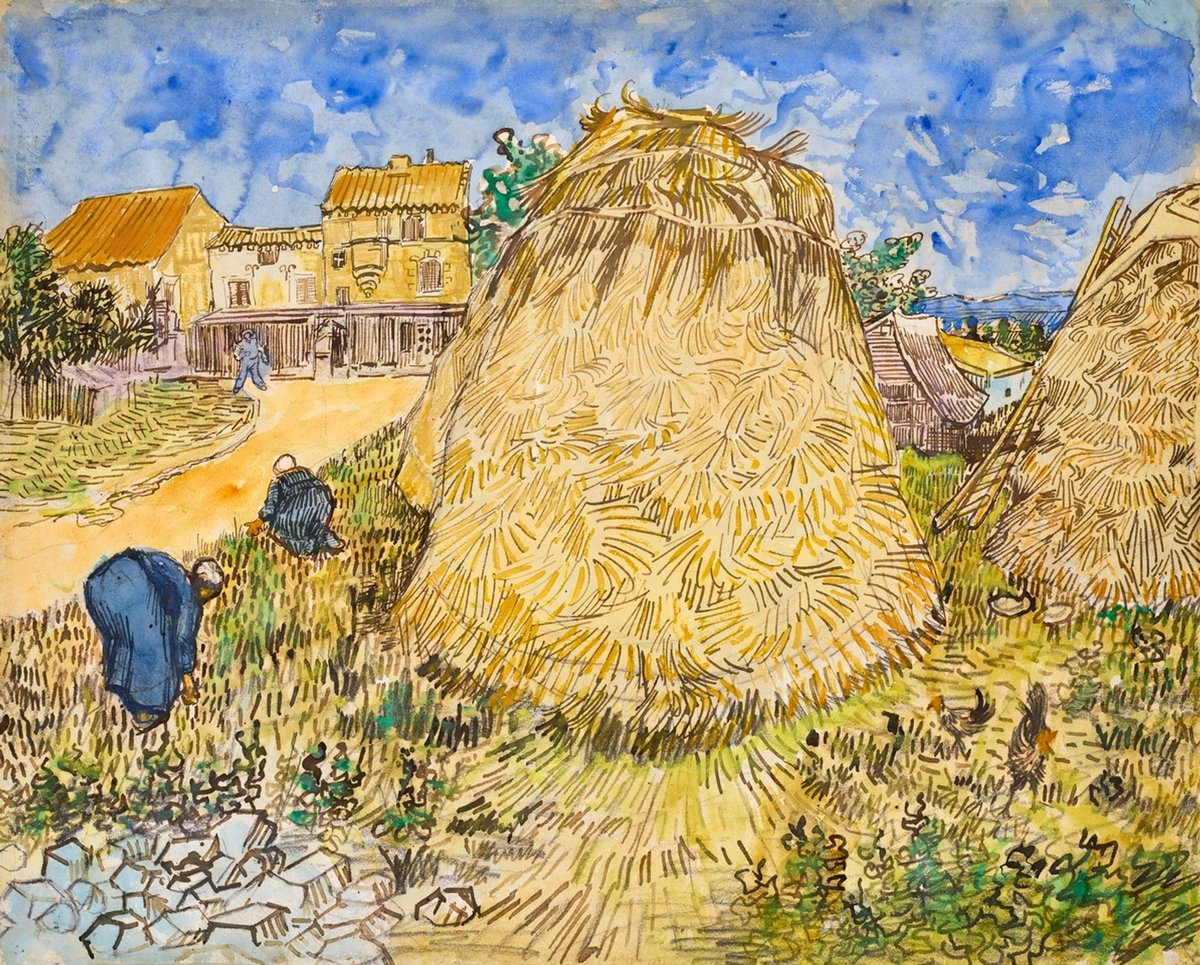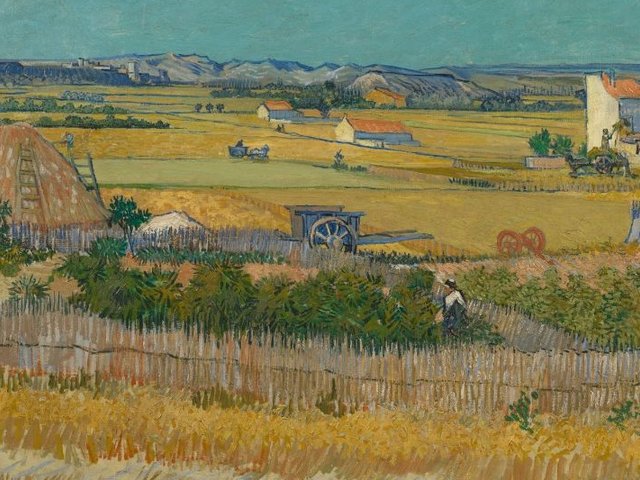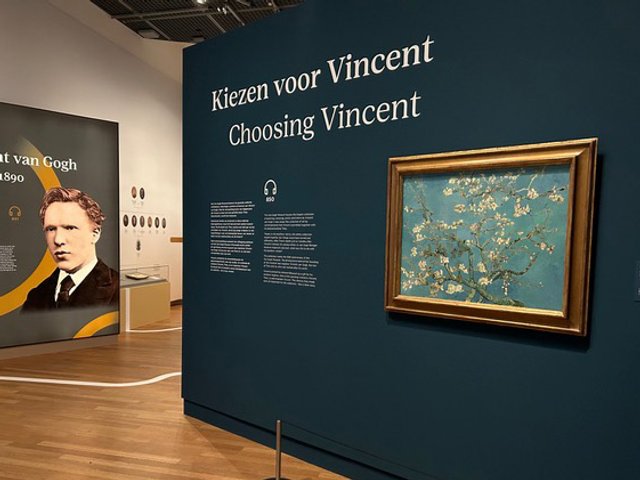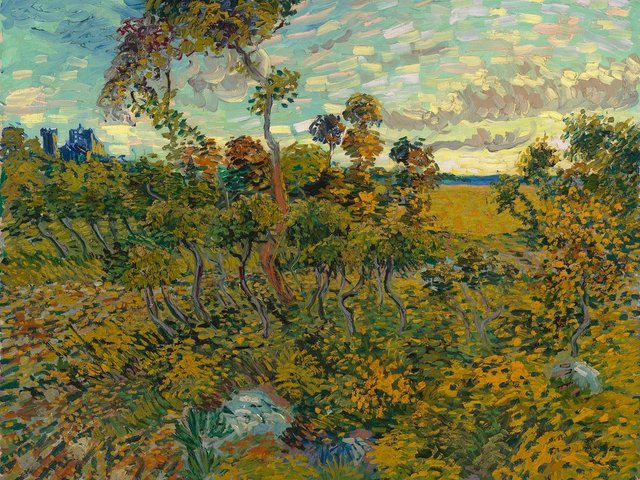Van Gogh’s magnificent watercolour Wheatstacks has always been hidden away in private collections. Last exhibited in 1905, it has only now been reproduced in colour. Last month I revealed how the painting was looted by the Nazis (it is now being sold by agreement with its pre-war owners). This week I am focussing on its subject matter—a modest farmyard on the outskirts of Arles, in Provence.
Van Gogh began the work by outlining some of the key elements in pencil. He then used an array of inked lines, dashes and dots, partly drawn with a reed pen. He would make these pens himself, from reeds he cut in the local canals. The use of thickish reed marks can be seen most clearly in the central wheatstack.
But it is the dazzling colours that bring the watercolour and gouache painting to life. Set under a loosely-painted sky, the harvested, golden wheat provides a dramatic contrast to the varied blues. The work also includes delightful details, such as a pair of chickens (which can easily be missed, in the lower-right corner).
At the back of the watercolour is the Mas (farm) de Griffeuille, named after its 17th-century owner Jacques Griffeuille. By Van Gogh’s time the farm was bordered by the Paris-Marseilles railway line and the Canal du Vigueirat. The view is near the entrance to the farm, facing north-east.
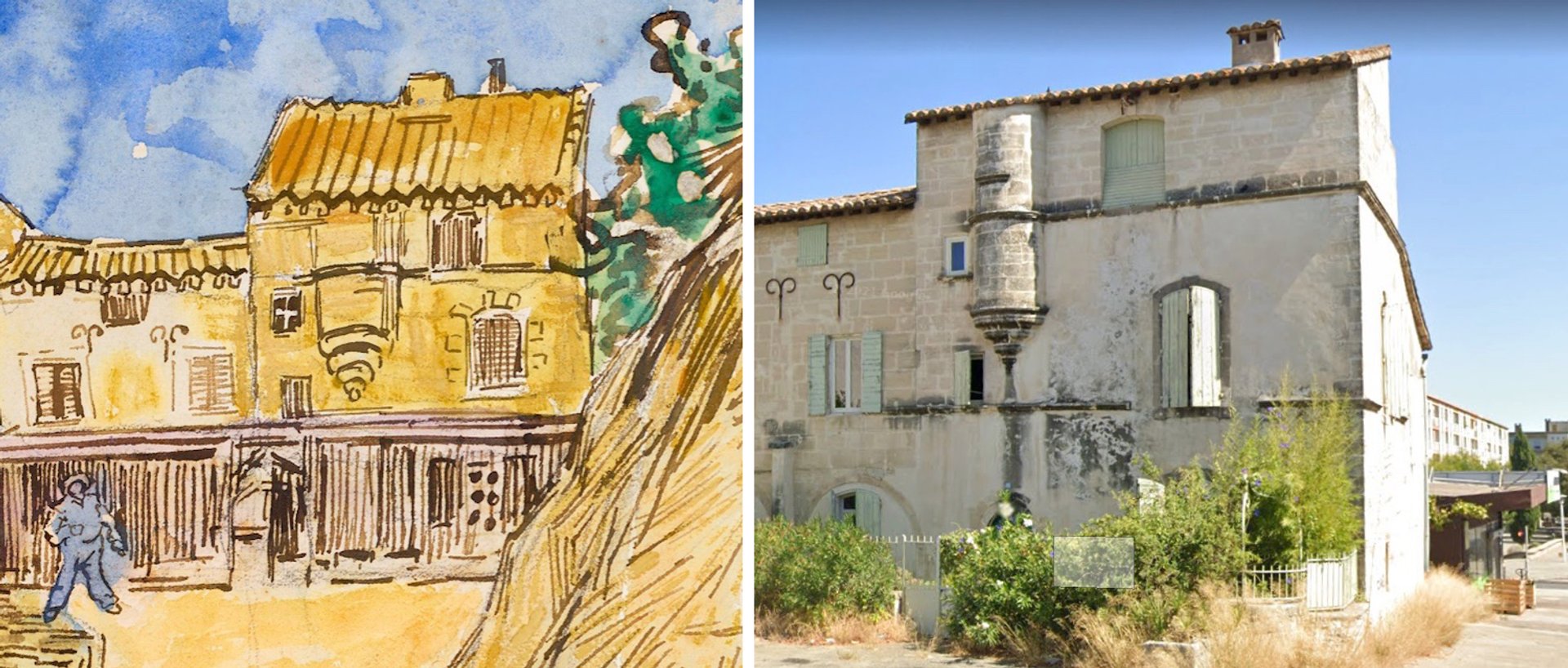
Van Gogh’s Wheatstacks (detail) and a recent photograph of the Mas de Griffeuille. Van Gogh: © Christie’s Images Ltd 2021
Most of the old farmhouse still survives in what is now the eastern suburbs of Arles (at 3 Rue Président J.F. Kennedy), marooned among nondescript 1960s apartment blocks. The left one of Van Gogh’s trio of linked buildings was sadly demolished around that time. But thanks to good fortune, the ancient farmhouse was not completely flattened in a decade when so much historic architecture was destroyed throughout Europe.
Although the central and right-hand buildings had deteriorated by the 2000s, they remain very much as in the artist’s day. Two distinguishing features in his watercolour are obvious: the pair of fleurs de lis anchor plates which help support the central building and the turret on the upper level of the right-hand building. Van Gogh’s watercolour suggests that in his time there was a verandah in front of the farmhouse.
Wheatstacks was painted on around 10 June 1888, just after the harvest had begun. Although the land was already becoming scorched, Van Gogh loved the colours and contrasts: “There’s old gold, bronze, copper in everything now, you might say, and that, with the green blue of the sky heated white-hot, produces a delightful colour which is exceedingly harmonious.”
In the watercolour, three stacks (one just visible behind the central one) have been piled up with newly harvested wheat. Two women, who are are drawn very similarly as in some of Van Gogh’s depictions of peasants of a few years earlier, appear to be picking up remnants of wheat left on the ground.
The man in blue just outside the house presumably represents the farmer. Van Gogh depicted a similarly posed figure in the public garden which lay just in front of the Yellow House, his home.

Van Gogh’s Entrance to the Public Gardens in Arles (October 1888). Courtesy of Phillips Collection, Washington, DC
Wheatstacks is clearly influenced by Japanese prints, which Van Gogh so admired. A few days before starting work Vincent had asked his brother Theo to send him art supplies: “The reason I asked for some watercolour paints is because I’d like to do some pen drawings, but coloured in flat tints like Japanese prints.” Although Van Gogh’s scene was painted under the glare of the midday sun, there are no shadows in the watercolour, a characteristic of Japanese art.
By 16 June 1888, just a few days after finishing the watercolour, he had sent it to Theo, saying: “The wheatstacks in a farmyard will seem too bizarre to you, but it was done in great haste as a project for a painting, and it’s to show you what it’s like.” Although completed quickly, this urgency has imparted a great immediacy to the work, particularly with the colouring.
A few days later Van Gogh made an oil painting of the same scene, a larger version with some minor changes. The three figures were eliminated, to be replaced by a single standing woman. Some shadows have been added.

Van Gogh’s Wheatstacks in Provence, oil (June 1888). Courtesy of the Kröller-Müller Museum, Otterlo
That summer Van Gogh drew copies of some of his recent paintings for two of his artist friends. These works included the oil painting of Wheatstacks, evidence that he was pleased with the final picture. He made the first drawing of Wheatstacks in early July to send to Emile Bernard, who was working in Saint-Briac, in Brittany. It is now at the Museum of Fine Arts in Budapest.
The second drawing, done later in the month, was for his Australian artist friend John Russell, who was staying on the island of Belle-Ile, off the Brittany coast. In 1897 Russell gave it to Henri Matisse, a young artist who visited him and expressed great admiration for Van Gogh (Vincent’s drawings would have a great influence on Matisse’s own work). Matisse’s son kept the drawing until the 1940s and it was acquired by the Philadelphia Museum of Art in 1962.

Van Gogh’s ink drawings: Wheatstacks in Provence, for Emile Bernard (July 1888), now in Budapest; and Wheatstacks in Provence, for John Russell (July 1888), now in Philadelphia. Courtesy of the Museum of Fine Arts, Budapest, and Philadelphia Museum of Art
Vincent was at his most creative that summer. While working on landscapes he felt a great empathy with the local farmers—and the challenges that they faced. As he wrote to Theo on 1 July 1888: “During the harvest my work has been no easier than that of the farmers themselves who do this harvesting. Far from my complaining about it, it’s precisely at these moments in artistic life… that I feel almost as happy as I could be in the ideal, the real life.”
Wheatstacks will be auctioned by Christie’s in New York on 11 November, as part of the Cox Collection. The estimate is $20m-$30m.
Other Van Gogh news
• Along with Wheatstacks and two other Van Gogh paintings from the Cox collection (Wooden Cabins among the Olive Trees and Cypresses and Young Man with a Cornflower), Christie’s is also selling a Nuenen landscape, Knotberken (Knot Birches), dating from May 1884. The sale will be on 11 November in New York, with Knot Birches, consigned by an anonymous collector, estimated at $4m-$6m.
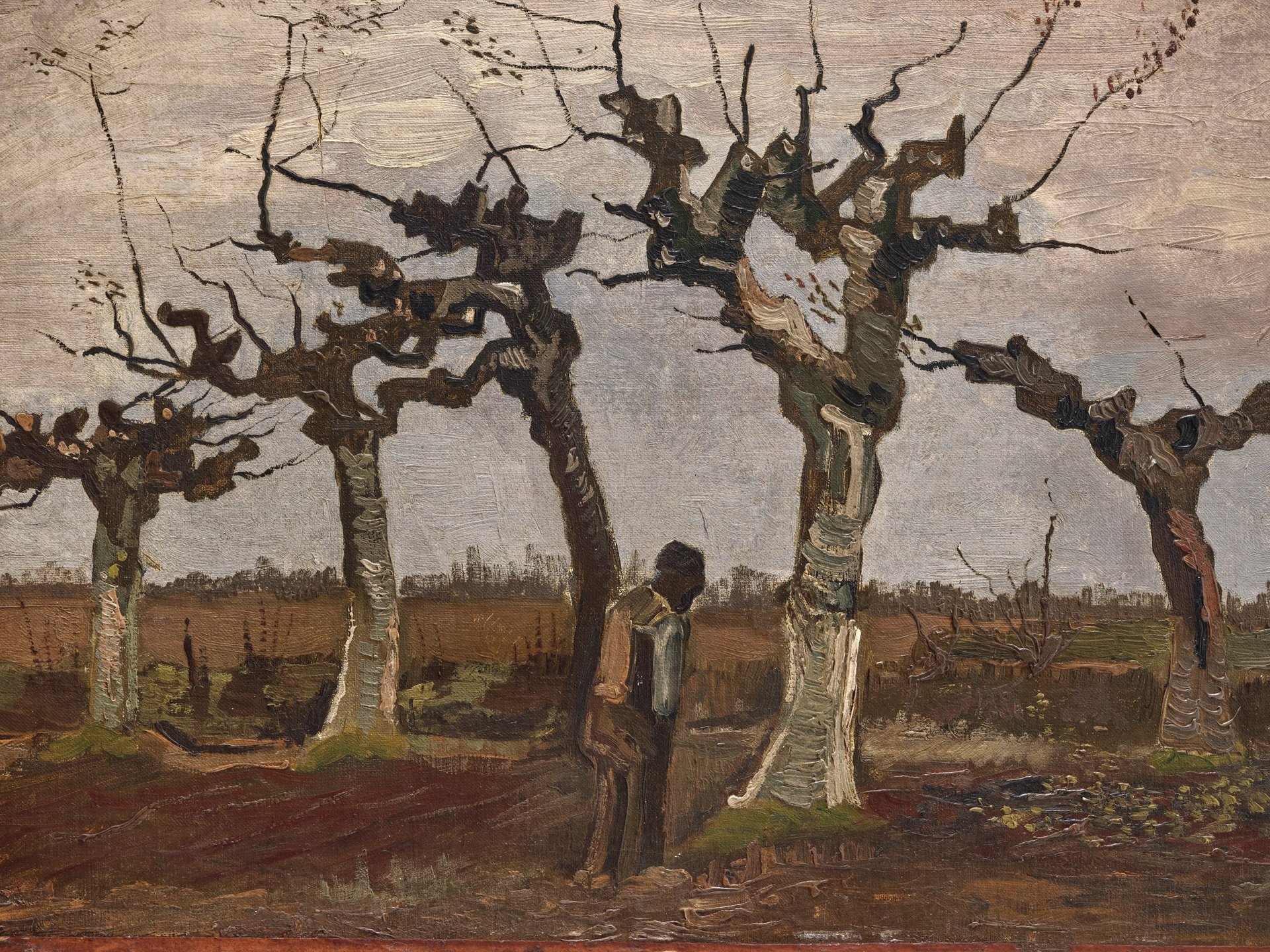
Knotberken (Knot Birches) (May 1884). © Christie’s Images Ltd 2021


